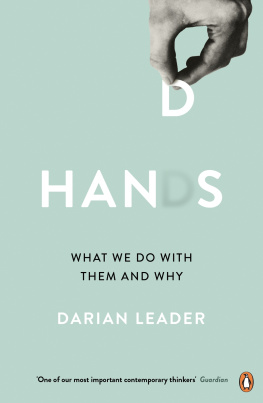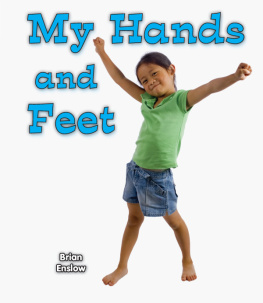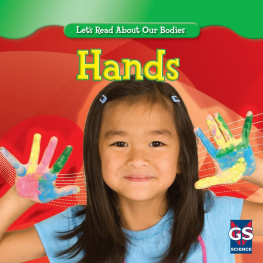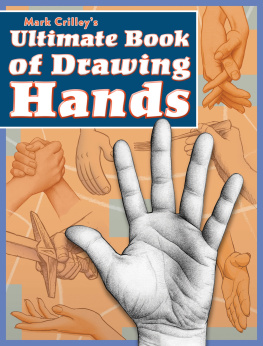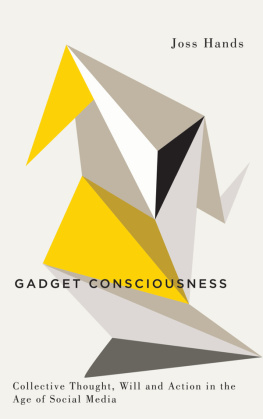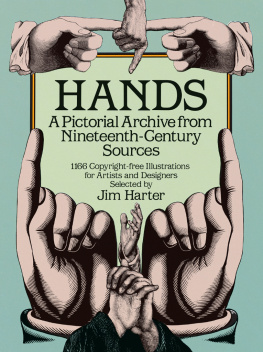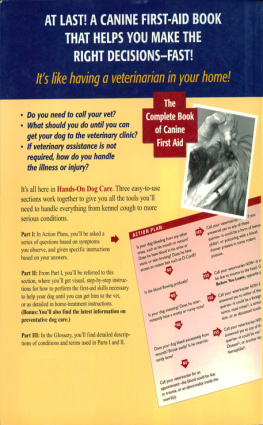Darian Leader
HANDS
By the Same Author
Introducing Lacan (with Judy Groves)
Why Do Women Write More Letters Than They Post?
Promises Lovers Make When It Gets Late
Freuds Footnotes
Stealing the Mona Lisa: What Art Stops Us from Seeing
Why Do People Get Ill? (with David Corfield)
The New Black: Mourning, Melancholia and Depression
What is Madness?
Strictly Bipolar
For Jack, Iris and Clem
1
The new era of the Internet, the smartphone and the PC has purportedly had radical effects on who we are and how we relate to each other. The old boundaries of space and time seem collapsed thanks to the digital technology that structures everyday life. We can communicate instantly across both vast and minute distances, Skyping a relative on another continent or texting a classmate sitting at the next table. Videos and photos course through the Web at the touch of a screen, and social media broadcast the minutiae of both public and private lives. In the train, the bus, the caf and the car, this is what people are doing, tapping and talking, browsing and clicking, scrolling and swiping.
Philosophers, social theorists, psychologists and anthropologists have all spoken of the new reality that we inhabit today in the twenty-first century as a result of these changes. Relationships are arguably more shallow or more profound, more durable or more transitory, more fragile or more grounded. As the workplace for many becomes virtual, new possibilities emerge to construct lives beyond the nine-to-five paradigm. Whatever we make of these changes, everyone seems to agree that they are indeed changes, that the world is a different place, that the digital era is something incontestably new.
But what if we were to see this chapter in human history through a slightly different lens? What if, rather than focusing on the new promises or discontents of contemporary civilization, we see todays changes as first and foremost changes in what human beings do with their hands? The digital age may have transformed many aspects of our experience, but its most obvious yet neglected feature is that it allows people to keep their hands busy in a variety of unprecedented ways.
The use of hands is indeed changing. The owner of the famous Shakespeare and Company bookshop describes the way that young people now try to turn pages by scrolling them, and Apple have even applied for patents for certain hand gestures. Patent application 7844915, filed in 2007, covered document scrolling and the pinch-to-zoom gesture, while the 2008 application 7479949 covered a range of multitouch gestures. Both were ruled invalid, not because gestures cant be patented but because they were already covered by prior patents.
At the same time, physicians observe massive increases in computer- and phone-related hand problems, as the fingers and wrist are being used for new movements that nothing has prepared them for. Changes to both the hard and soft tissues of the hand itself are predicted as a consequence of this new regime. We will, ultimately, have different hands, in the same way that the structure of the mouth has been altered, it is argued, by the introduction of cutlery, which changed the topography of the bite. The edge-to-edge bite that we used to have up to around 250 years ago became the overbite, with the top incisors hanging over the lower set, thanks to new ways of cutting up food that the table knife made possible. That the body is secondary to the technology here is echoed in the branding of todays products: it is the pad and the phone that are capitalized in the iPad and iPhone rather than the I of the user.
Yet if the way that we employ our hands is changing, the fact that we have to keep our hands busy is nothing new. From weaving to spinning to knitting to texting, human beings have always kept their hands occupied. If the playground parent would once have been knitting or turning the pages of a newspaper, today they are texting and surfing. At home, computer games occupy the hands and fingers, and Minecraft, the worlds most successful game, includes a curious onscreen hand that accompanies the player wherever they go. The phenomenal popularity of Lego, likewise, is not just due to clever marketing but to its basic function of giving work to the hands.
Once we recognize the importance of keeping the hands busy, we can start to think about the reasons for this strange necessity. What are the dangers of idle hands? What function does relentless hand activity really have? What role do the hands have for the infant and how does this change during childhood? What links are there between hand and mouth? And what happens when we are prevented from using our hands? The anxious, irritable and even desperate states we might then experience show that keeping the hands busy is not a matter of whimsy or leisure, but touches on something at the heart of our embodied existence.
And this brings us to a paradox that will run throughout the pages to follow. The most obvious answer to the above questions is that we need our hands to do things with. They serve us. They are the instruments of executive action, our tools. They allow us to manipulate the world so that our wishes can be fulfilled. We show our hands to vote, to seal an agreement, to confirm a union, to such an extent that the hand is often used to stand for the human agent that bears it. In zombie and Frankenstein movies, the creatures walk with hands held out in front of them, not to suggest difficulties in vision but, on the contrary, pure purpose.
Yet at the same time, our hands are precisely what disobey. Although there are stories and films where a body part such as an eye, a foot or even an ear becomes animated or possessed, this is nothing compared to the vast number of examples where it is the hand either joined to the body or severed that starts to function on its own, and nearly always murderously. When body parts become possessed in horror films, from The Hands of Orlac to Evil Dead, it is almost always the hands that are controlled by some evil force, rather than the feet, the eyes or the mouth.
In most of these fictions, the hands act in opposition to the conscious volition of the person. They may perpetrate the murder or revenge that the person at some level desires, but which society and their own self-image prohibit. In The Hand, the comic-book artist played by Michael Caine has to discover that the carnage wreaked against those who have wronged him is in fact the work of his own severed hand. In other scenarios, the hands may embody the will of someone else entirely, perhaps a spirit or the donor of the surgically grafted member. Whatever the case, they show a division or splitting, as the unhappy hero of these sagas has to fight against their own body.
And dont such divisions persist in everyday life? As we might strive to focus on what our partner or friend is telling us, our hands itch to send a text, to check our email, to update our Facebook page. People complain of being too attached to their phones and tablets and iPads, as if their hands just cant stop touching them. The hand, symbol of human agency and ownership, is also a part of ourselves that escapes us. In what has become one of the most successful cultural products of all time, Disneys

